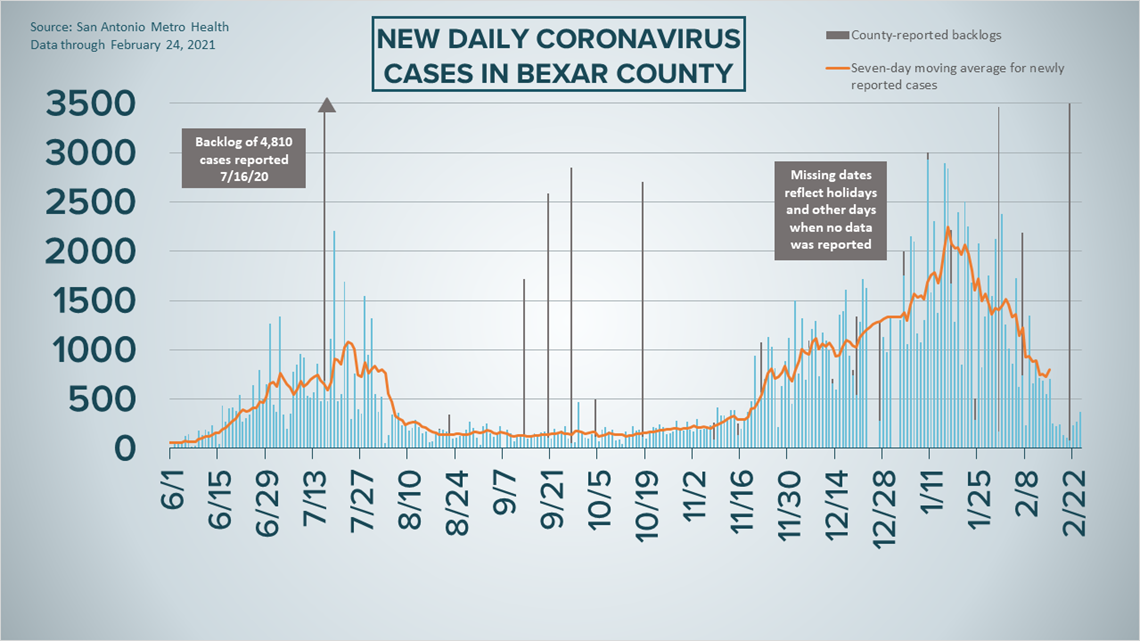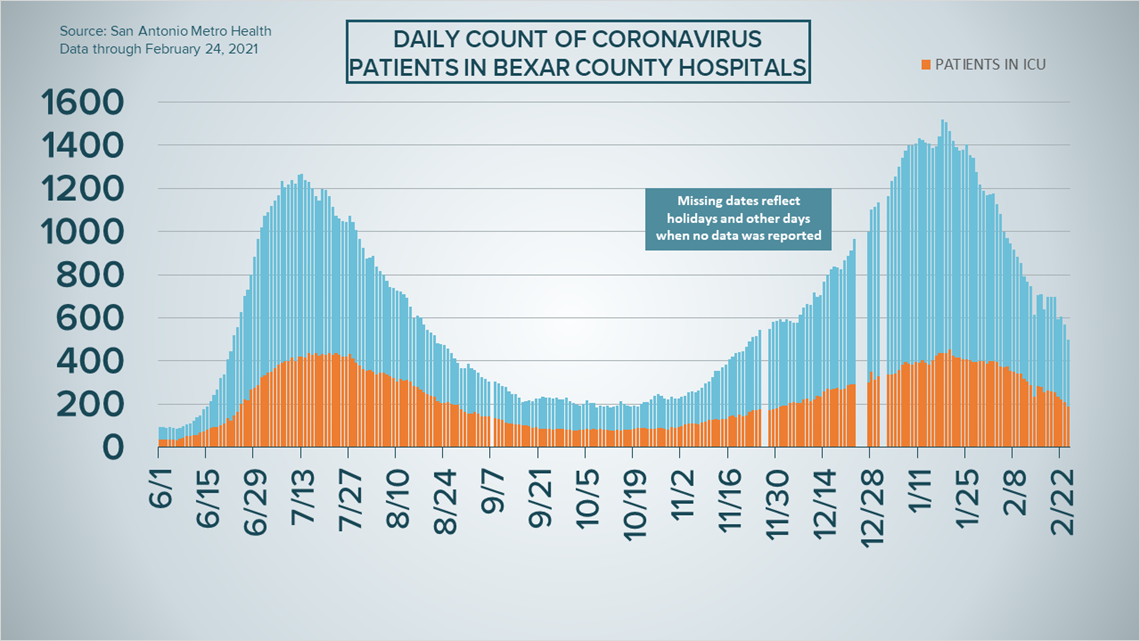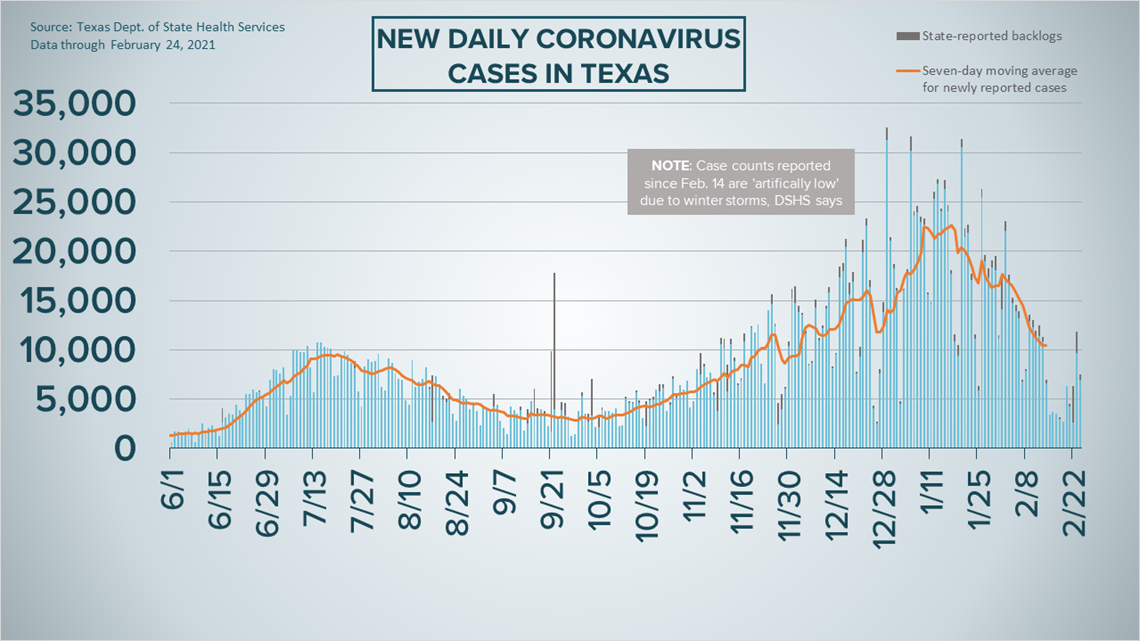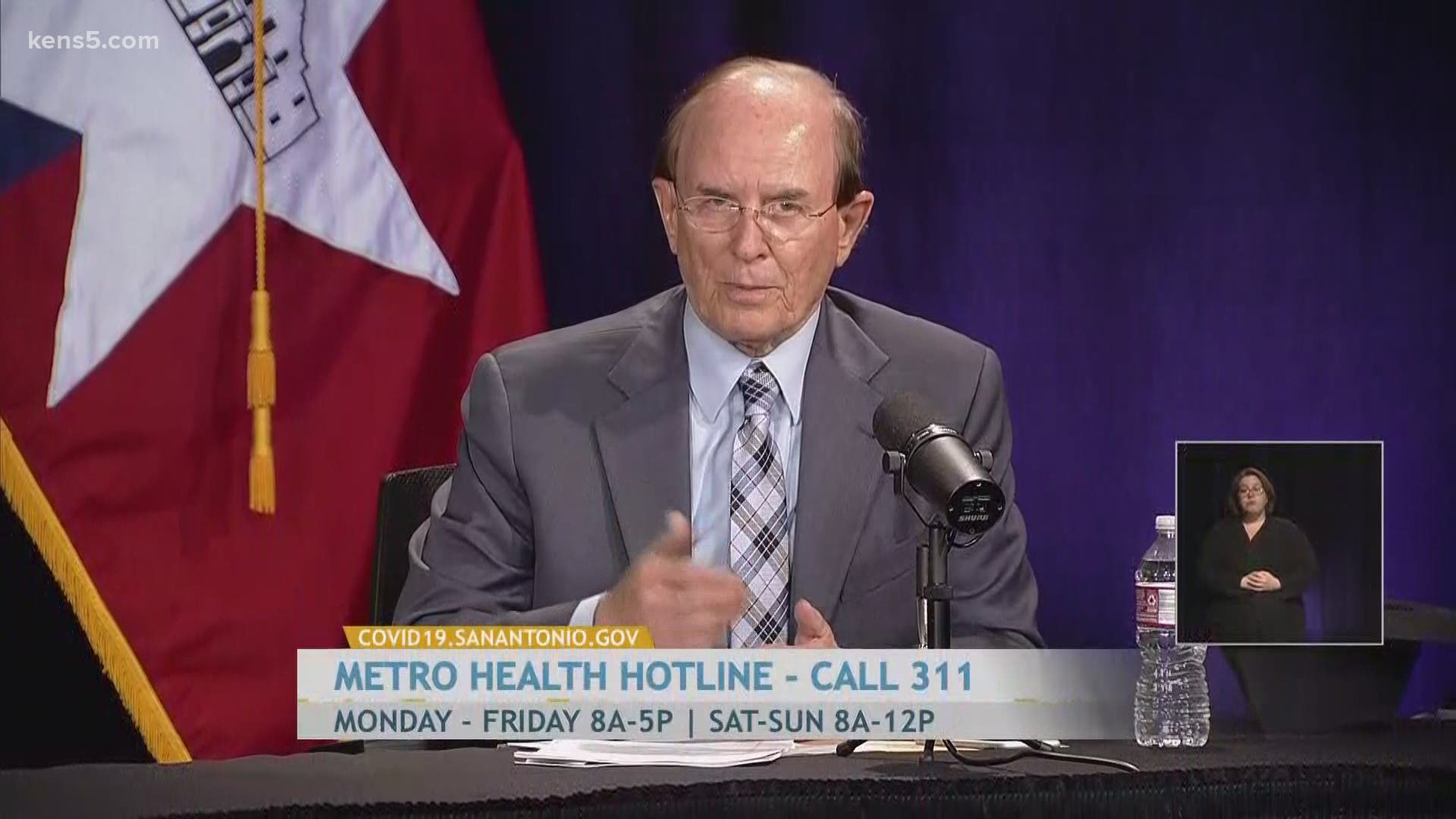SAN ANTONIO — We're tracking the latest numbers from the coronavirus pandemic in San Antonio and across Texas. Here are the latest numbers reported by Bexar and surrounding counties:
- Bexar County: On Wednesday, 371 new cases were reported, bringing the total number of cases to 194,332. Nine new deaths were also reported, raising the local death toll to 2,510.
- Hays County: On Wednesday, officials reported 62 new cases in the county and no additional COVID-related fatalities. There is now a total of 16,182 lab-confirmed local cases, while the death toll remains at 209. Officials estimate 15,434 residents have recovered, while 539 are still ill with the virus on this date.
- Comal County: Officials reported 48 new cases and no additional COVID-related fatalities on Wednesday. As of Wednesday, 8,959 total COVID-19 cases have been reported, including 4,726 confirmed and 4,214 probable cases, while 284 county residents have died due to COVID-19 complications.
More county case information is available through the Texas Department of Health Services COVID-19 dashboard.
How Bexar County is trending
We've tracked how many coronavirus cases have been confirmed in Bexar County from the time officials began reporting cases in March 2020. The graphic below shows the number of cases since June and charts those daily case numbers along a 7-day moving average to provide a more accurate picture of the overall coronavirus case curve in our area and the direction we're trending amid the pandemic.
On Wednesday, Mayor Ron Nirenberg reported an additional 371 new coronavirus cases in Bexar County, raising the local total to 194,332 diagnoses in the ongoing pandemic.
Nirenberg also reported nine additional virus-related deaths, raising the local death toll to 2,510.


Wednesday brought another large drop in coronavirus hospitalizations, with 499 COVID-19 patients receiving treatment for their symptoms at local facilities. That's a drop of 70 from Tuesday. The last time Bexar County reported fewer than 500 local hospitalizations was on Nov. 22.
Of those 499 patients, 190 are in intensive care and 115 are on ventilators; both are also drops from Tuesday.


Coronavirus in Texas
The total number of novel coronavirus cases in the state since the pandemic began grew by 7,517 on Wednesday, according to the Texas Department of State Health Services. That total includes 4,991 new confirmed cases, 2,009 new probable cases, and a backlog of 517. More details can be found on this page.
Wednesday's figures bring the total number of Texans diagnosed with COVID-19 to more than 2.613 million.


Meanwhile, state health authorities reported an additional 339 deaths from coronavirus complications in Texas. In all, 41,980 Texans have died from COVID-19.
After seeing a small increase Tuesday, Texas hospitalizations plummeted on Wednesday to continue a general downward trend that began in mid-January. The number of COVID-19 patients receiving treatment for their symptoms throughout Texas decreased by 276, to a current count of 6,738 on Wednesday. That's the lowest the number has been since Nov. 11.
The state, meanwhile, estimates that about 2.368 million Texans have recovered, while 185,190 Texans remain ill with COVID-19.
The latest update from the Texas Education Agency showed that there have been at least 175,077 cumulative cases among staff and students on Texas public school campuses through Feb. 7. That number comprises 113,311 positive student cases and 61,766 staff cases. More information can be found here.
The TEA typically releases new data on school cases on Fridays, but last week's data is delayed due to the past week's storms.
Latest Coronavirus Headlines
- NIH to study 'long-haul' coronavirus symptoms, and their effects
- Third stimulus check: Potential timeline for $1,400 payments
- COVID-19 Vaccine Tracker: Fast facts and how to participate in Phase 1B distribution in San Antonio
- U.K. studies show COVID-19 vaccines led to sharp drop in hospital admissions
- VERIFY: KN95, N95, cloth, disposable. Which masks work best, according to the CDC?
- FDA staff releases review of Johnson & Johnson single-dose COVID vaccine
- Biden aims to distribute masks to millions in 'equity' push
- Texas’ COVID-19 vaccinations begin to rebound after plunging during last week’s winter storm
Coronavirus symptoms
The symptoms of coronavirus can be similar to the flu or a bad cold. Symptoms include fever or chills, cough, shortness of breath or difficulty breathing, fatigue, muscle or body aches, headache, new loss of taste or smell sore throat, congestion or runny nose, nausea or vomiting, and diarrhea, according to the Centers for Disease Control.
Most healthy people will have mild symptoms. A study of more than 72,000 patients by the Centers for Disease Control in China showed 80 percent of the cases there were mild.
But infections can cause pneumonia, severe acute respiratory syndrome, kidney failure, and even death, according to the World Health Organization. Older people with underlying health conditions are most at risk.
Experts determined there was consistent evidence these conditions increase a person's risk, regardless of age:
- Chronic kidney disease
- COPD (chronic obstructive pulmonary disease)
- Obesity (BMI of 30 or higher)
- Immunocompromised state (weakened immune system) from solid organ transplant
- Serious heart conditions, such as heart failure, coronary artery disease, or cardiomyopathies
- Sickle cell disease
- Type 2 diabetes
The CDC believes symptoms may appear anywhere from two to 14 days after being exposed.
Human coronaviruses are usually spread...
- Between people who are in close contact with one another (within about 6 feet).
- Through respiratory droplets produced when an infected person coughs, sneezes or talks. These droplets can land in the mouths or noses of people who are nearby or possibly be inhaled into the lungs.
- Some recent studies have suggested that COVID-19 may be spread by people who are not showing symptoms.
Help stop the spread of coronavirus
- Stay home when you are sick.
- Eat and sleep separately from your family members
- Use different utensils and dishes
- Cover your cough or sneeze with your arm, not your hand.
- If you use a tissue, throw it in the trash.
Find a Testing Location
City officials recommend getting a COVID-19 test if you experience fever or chills, cough, shortness of breath or difficulty breathing, fatigue, muscle or body aches, headache, new loss of taste or smell, sore throat, congestion or runny nose, nausea or vomiting, or diarrhea.
A self-screening tool is available to see if you need a test.
San Antonio operates several no-cost testing locations, including two walk-up locations open Monday-Sunday from 10 a.m. until 2 p.m.:
Cuellar Community Center
5626 San Fernando St.
San Antonio, TX 78237Ramirez Community Center
1011 Gillette Blvd.
San Antonio, TX 78224Additionally, Freeman Coliseum offers drive-through no-cost testing from Monday through Sunday between 9 a.m. and 4 p.m. An appointment is required and can be made either online or by calling (833) 213-0643.
Here's a Testing Sites Locator to help you find the testing location closest to you in San Antonio.

